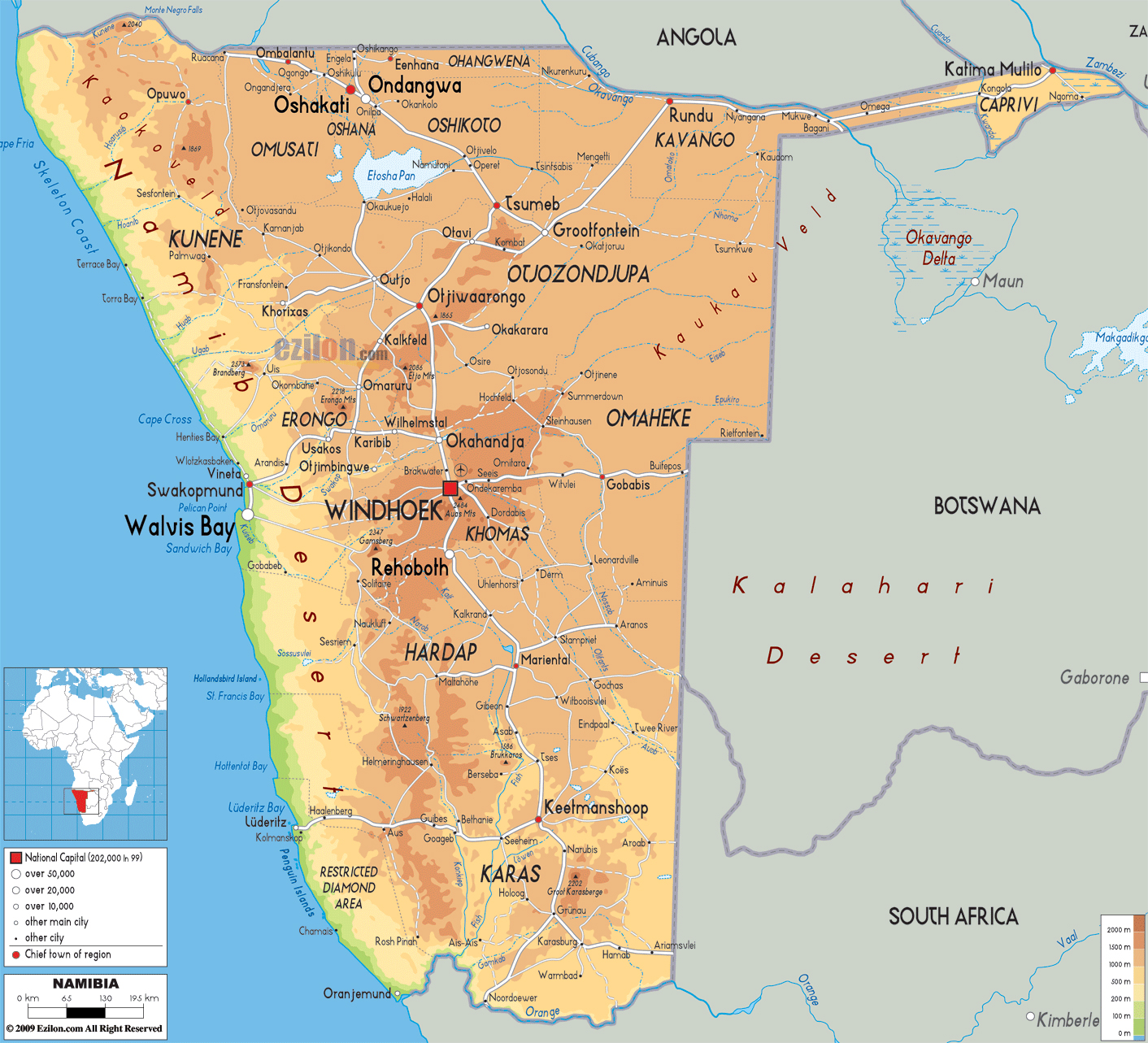
Shared with South Africa and Botswana, it has a variety of localised environments ranging from hyper-arid sandy desert, to areas that seem to defy the common definition of desert. The Kalahari Desert is perhaps Namibia’s best known geographical feature.

Thunderstorm in the Kalahari near Stampriet

The Bushveld area has been demarcated by the World Wildlife Fund as part of the Angolan mopane woodlands ecoregion, which extends north across the Cunene River into neighbouring Angola. The area is ecologically important and vital to the huge numbers of birds and animals from the surrounding savannah that gather in the region as summer drought forces them to the scattered waterholes that ring the pan. For most of the year it is a dry, saline wasteland, but during the wet season, it forms a shallow lake covering more than 6,000 square kilometres (2,317 sq mi). Located adjacent to the Bushveld in north-central Namibia is one of nature’s most spectacular features: the Etosha pan. The area is generally flat and the soils sandy, limiting their ability to retain water. Temperatures are also cooler and more moderate, with approximate seasonal variations of between 10 and 30 ☌ (50 and 86 ☏). The area receives a significantly greater amount of precipitation than the rest of the country, averaging around 400 mm (15.7 in) per year. The Bushveld is found in north eastern Namibia along the Angolan border and in the Caprivi Strip which is the vestige of a narrow corridor demarcated for the German Empire to access the Zambezi River. A number of Acacia species are found here, as well as grasses and other shrub vegetation. Vegetation along the escarpment varies in both form and density, with community structure ranging from dense woodlands to more shrubby areas with scattered trees. The water, along with rapidly changing topography, is responsible for the creation of microhabitats which offer a wide range of organisms, many of them endemic. As summer winds are forced over the Escarpment, moisture is extracted as precipitation. Although the area is rocky with poorly developed soils, it is nonetheless significantly more productive than the Namib Desert. Average temperatures and temperature ranges increase as you move further inland from the cold Atlantic waters, while the lingering coastal fogs slowly diminish. The Great Escarpment swiftly rises to over 2,000 metres (6,562 ft). In many areas within the Namib Desert, there is little vegetation with the exception of lichens found in the gravel plains, and in dry river beds where plants can access subterranean water. In areas where the supply of sand is reduced because of the inability of the sand to cross riverbeds, the winds also scour the land to form large gravel plains. The prevailing south west winds then pick up and redeposit the sand in the form of massive dunes in the widespread sand sea, the largest sand dunes in the world. As sand-laden waters drop their suspended loads into the Atlantic, onshore currents deposit them along the shore. The sands that make up the sand sea are a consequence of erosional processes that take place within the Orange River valley and areas further to the south. Areas within the Namib include the Skeleton Coast and the Kaokoveld in the north and the extensive Namib Sand Sea along the central coast. The Namib Desert is a broad expanse of hyper-arid gravel, gravel with no moisture, plains and dunes that stretches along the entire coastline, which varies in width between 100 and many hundreds of kilometres.

Summer temperatures in the area can reach 40 ☌ (104 ☏), and frosts are common in the winter. The abiotic conditions here are similar to those found along the Escarpment however, the topographic complexity is reduced. Although arable land accounts for only 1% of Namibia, nearly 1/3rd of the population is employed in agriculture. Windhoek, the nation’s capital, is located here, as well as most of the arable land. Within the wide, flat Central Plateau is the majority of Namibia’s population and economic activity. The Central Plateau is home to the highest point in Namibia at Königstein elevation 2,606 metres (8,550 ft).

The Central Plateau runs from north to south, bordered by the Skeleton Coast to the northwest, the Namib Desert and its coastal plains to the southwest, the Orange River to the south, and the Kalahari Desert to the east. The Namibian landscape consists generally of five geographical areas, each with characteristic abiotic conditions and vegetation with some variation within and overlap between them: the Central Plateau, the Namib Desert, the Great Escarpment, the Bushveld, and the Kalahari Desert.


 0 kommentar(er)
0 kommentar(er)
